"To meet the needs of a living architecture," opined Otti Berger in 1930, "we need clarity about what fabric is, and further, what fabric in space is".1
With the showcase Otti Berger. Weaving for Modernist Architecture the Temporary Bauhaus-Archiv, Berlin, allow one to begin to approach appreciations of what both Otti Berger understood as fabric, "and further, what fabric in space is", and in doing so not only enable differentiated perspectives on Weaving and Modernist Architecture but allow Otti Berger to begin to retake her place on the helix of design, and architecture, (hi)story......
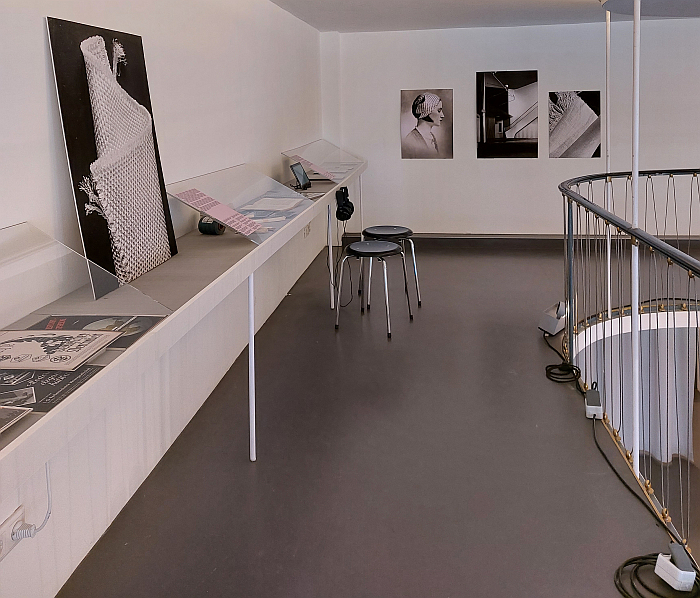
Born in the, then, village of Vörösmart, Austria-Hungary, the, now, village of Zmajevac, Croatia, on October 4th 1898, Otilija Ester Berger attended schools in Pécs and Vienna before enrolling in 1921 at the Royal Academy of Arts and Crafts, Zagreb. Following, as best we can ascertain, the completion of her studies in Zagreb, Berger travelled in 1926 to Germany where she both sought help in Berlin and Jena for hearing damage suffered in her teenage years2, and, in January 1927, enrolled at Bauhaus Dessau. In how far the two events were related we no know, nor do we we know if we'd rather that Bauhaus Dessau was the intended destination and the chance taken en route to consult German medics, or that Bauhaus was an institution discovered (by chance) once in Germany for treatment. What we do know is that following completion of the compulsory Vorkurs under László Moholy-Nagy and Josef Albers, Berger joined, somewhat inevitably, the Bauhaus Dessau Weaving Workshop. If a workshop, or perhaps more accurately a weaving, that, in contrast to many of her contemporaries, was clearly very much to Berger's liking, very much her favoured medium, and became her primary occupation.
In 1929, while still officially a student, Berger began teaching part-time in the Dessau Weaving Workshop, working alongside Anni Albers, and in the summer of 1930, briefly, substituted for the, then, Werkmeister Gunta Stölzl, before in October 1930 passing her Gessellen, Journeyman, exam at the Weaver's Guild in Glauchau, Sachsen, an institution who, according to Evelyn Schweynoch3, were responsible for assessing all Bauhaus weavers' and setting the Gessellen exams, for lest we forget a Bauhaus eduction was, essentially, an apprenticeship in which one learned a trade; and a location for the Gessellen exams, and the, as we shall see, close relationships between Otti Berger and Sachsen, that tends to underscore the historic importance of textiles in the area. Upon receipt of her Bauhaus Diploma in November 1930 Berger left Dessau to take up a position, essentially a position as a designer, even if that term as such didn't exist then, with first the curtain manufacturer Hoffamnn, Fischer & Co in Zwickau, Sachsen, and subsequently with the Websky, Hartmann & Wiesen textile mill in, then, Wüstewaltersdorf, now Valim, eastern Poland, before returning to Dessau in October 1931 to retake a teaching position at Bauhaus; a return to Dessau that included a, second, brief, period in charge of the Weaving Workshop prior to Lilly Reich's arrival in 1932 as head of both the Weaving Workshop and the so-called Ausbauabteilung, a combined metal/wood/furniture/interiors workshop. And a return to Dessau that saw Otti Berger begin to develop her own textile projects.
Textile projects she continued following the formal dissolution of Bauhaus in September 1932 in the guise of the Berlin based Atelier für Textilien Otti Berger, a move into freelance work in your own studio that for all it is commonplace, normal, today was, then, anything but, certainly for a female creative; and an Atelier from where Berger cooperated with an impressive roster of partners including, and amongst others, Hans Scharoun for whom she designed curtains and furniture material for his Haus Schminke project in Löbau, Sachsen, a work, much like Berger, that belongs to the more regularly overlooked expressions of the period; Zürich based interiors company Wohnbedarf, one of the earliest adopters of Modernist Functionalist interior and furnishing positions and from whom, as previously noted, Aino Aalto purchased examples of Berger's textiles during the research that led to the establishment of Artek; or Dresden based horsehair weaving specialists Schriever & Co with whom Berger realised numerous furniture fabrics including fabrics based on a novel double weave material she had developed employing a synthetic horsehair. One of numerous novel materials and processes developed by Otti Berger that were/are at the core of her work and that allow one to appreciate her as a designer as understood in the contemporary sense of combining cultural and artistic influences with engineering and science in both open-ended, iterative research and commercially orientated cooperations with industry; and novel materials and processes for which she applied, if largely unsuccessfully, certainly in the Germany of that day, for patents.
A Germany of that day which in May 1936 prohibited Otti Berger from working as a weaver on account of her Jewish ancestry, if but a component of the increasingly hostile environment within the Germany of that day, and which saw Otti Berger leave that Germany and, after brief periods in France and the Netherlands, the later seeing her stay with Mart Stam and his, then, wife Lotte Stam-Beese, a contemporary of Berger's at Bauhaus Dessau if not of the Weaving Workshop, move to London in September 1938, with the intention of continuing on to America where László Moholy-Nagy had invited her to join the teaching staff of his School of Design, Chicago. But an America for which she required a visa, a visa not only Moholy-Nagy, but, and amongst others, Walter Gropius, Ludwig Mies van der Rohe, and Berger's long time partner Ludwig Hilberseimer, sought to facilitate the granting of. But sought in vain. In the autumn of 1938 Otti Berger, partly on account of her lack of success in establishing herself professionally in England, and partly on account of her sick mother, returned to Zmajevac where she continued working, and continued, fruitlessly, in her attempts to acquire a US visa, before, in the spring of 1944, along with her brothers Oskar and Otto and her sister-in-law Elsa, Berger was deported to the Mohács ghetto.
Otti Berger was murdered in Auschwitz in July 1944, aged just 45.4
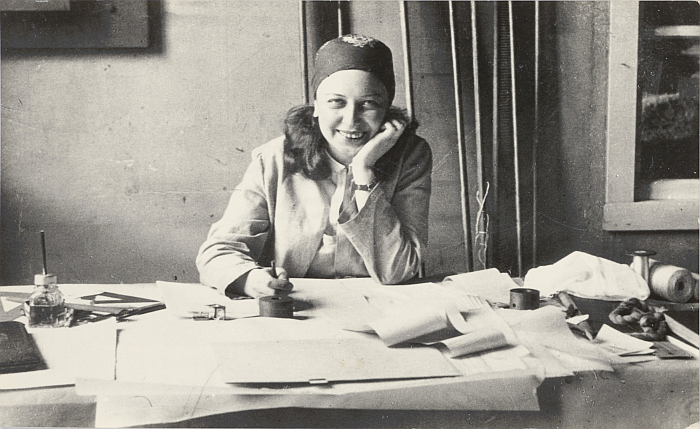
Based on a long, involved, multi-disciplinary research project by Berlin based visual artist Judith Raum, and realised in close cooperation with Palingen, near Lübeck, based textile designer Katja Stelz, and the Bauhaus-Archiv, Berlin, Otti Berger. Weaving for Modernist Architecture presents itself as, essentially, six concise vitrines which alongside explaining the complexities of that research project, not least on account of the geographic, global, distribution of the archival material and textiles, a regular contributing factor for a creative's slip into anonymity, also help elucidate Berger's use of both natural materials including a raffia won from Ramie, a.k.a Boehmeria nivea, a native of eastern Asia, with, yes, and as discussed from All Hands On: Basketry at the Museum Europäischer Kulturen, Berlin, all the questions of Colonialism such an innocuous statement brings, must bring, with it, and also her use of the novel synthetic materials being advanced by the burgeoning chemical industry of the early decades of the 20th century, one of the more powerful motors of the period, including the aforementioned synthetic horsehair and, and equally importantly in the Berger oeuvre, cellophane, a material one learns rose to an almost unimaginable relevance in the 1920s and 30s. An importance, and informativness, of synthetic and natural materials in Bergers' oeuvre shared with the so-called bauhaus vorhangstoffe gewebt gittertülle collection, a collection of curtain fabrics developed in the Bauhaus Desssau Weaving Workshop from a lattice tulle material and of which Berger was very much the guiding light, and fabrics which entered production in spring 1933 with Lengenfeld, Sachsen, based C.E. Baumgärtel & Sohn as one of the last commercial Bauhaus products. And vitrines that also makes mention of Berger's writings on textiles, text-tiles when one so will, and while not, as best we can ascertain, an overly prolific writer the existence of any volume of texts by a creative no longer with us is, as oft noted in these dispatches, important, fundamental, in allowing that creative's voice to be heard and to contribute to contemporary discourses. And as Weaving for Modernist Architecture allows one to gauge, an Otti Berger's contribution to contemporary discourses is not without its relevance and value.
Six vitrines supported by two video installations by Judith Raum: Stoffbesprechung which concerns itself with Berger's writings and Textile Territories which juxtaposes Berger with Lilly Reich, and which allow for a widening and deepening of the presentation despite the very real spatial limitations of the Temporary Bauhaus-Archiv.
Six vitrines containing an array of objects including, for example, patent applications and associated correspondence, archive photos of Bergers textiles, photos from and off the research into and of Berger's textiles, and also recreations by Katja Stelz of two wall fabrics developed by Berger, one in Ramie the other employing cellulose, fabrics visitors are invited, encouraged, to feel, to get to know physically as much as theoretically. An invitation that is not only very welcome, but also very much in keeping with Otti Berger's position that "the value of a fabric should be discerned from the tactile, through the sense of touch before all else" and that "tactility is paramount in fabric. A fabric should be taken hold of and felt, it must be possible to "grasp" it by feeling it with one’s hands!" And not just looked at as we all tend to believe today, not be confused for primarily something visual as we all do today.
And a physical approach to understanding a material which is also symbolic of the research that was undertaken, was necessary, to approach more nuanced appreciations of Otti Berger's works, and thereby to approach more probable, more meaningful appreciations of not only Otti Berger but of 1920s and 1930s architecture and design and weaving.
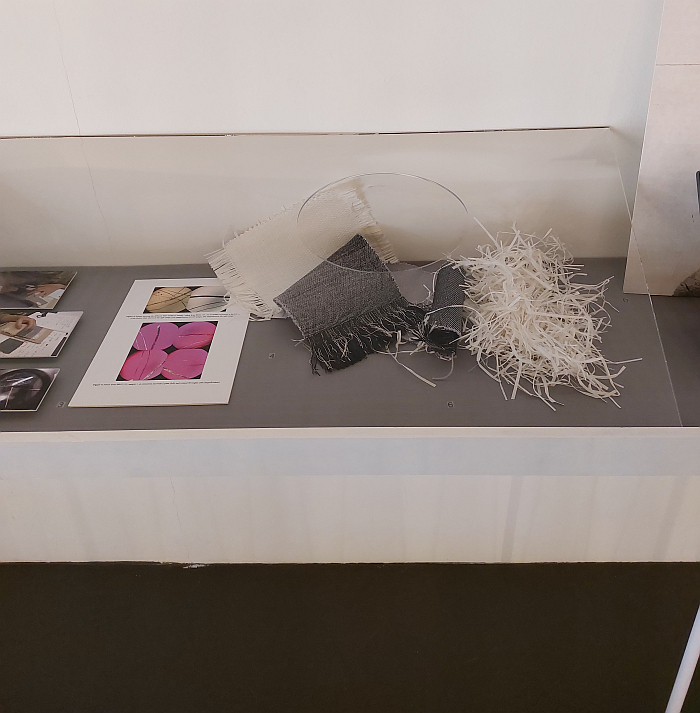
Research that was not only complicated in terms of the geographic distribution of the archive materials, but also on account of how textiles are conventionally archived and presented i.e. flat, and invariably in small pieces in books, a format, formats, that not only tends to skew understandings of any given textile, but that in the case of Otti Berger's work denies the textiles their intended functionality.
A functionality that was very much of the age, a functionality that was very much in context of the developments of the age; and that not just in context of the novel positions on and approaches to the architecture of the exhibition title, an architecture that required a re-thinking, a re-imagining of textiles, but also in context of the novel cultural and social developments of the age, including, for example, the rise of cinema, the rise of automobiles and also the rise of aircraft, pun intended, the latter objects whose interiors in the 1920s and 1930s bear only a passing resemblance to those of today, and which were spaces that a great many designers of the period discovered as a novel context, as a novel question in need of a contemporary answer, including Otti Berger who not only busied herself with the theoretical and practical aspects of aircraft textiles but developed fabrics for use as furniture and wall coverings in aircraft interiors, including the aforementioned cellophane containing fabric. Considerations on aircraft textiles also undertaken by Margaretha Reichardt, Berger's contemporary in the Dessau Weaving Workshop and whose Eisengarn, a material that despite what you may think didn't contain iron but rather, as noted from Four "Bauhausmädels" at the Angermuseum, Erfurt, is a cotton thread fortified with starch, wax and paraffin oil that resembles iron, was, as we all learned from Anton Lorenz: From Avant-Garde to Industry at the Vitra Design Museum Schaudepot, considered by Lorenz and Hans Luckhardt for a reclining chair the latter was developing for Air France, the reclining aircraft chair being at that stage a contemporary answer to a novel question and not the source of untold heated arguments it became. And thoughts on textiles for aircraft initiated in Weaving for Modernist Architecture that help underscore that for all the images of camaraderie and community popularly associated with the Bauhauses, there was real, hard, competition between the varying protagonists. And often hostilities. See also the aforementioned videos Stoffbesprechung and Textile Territories for further examples, videos that we do hope at some stage can be made freely publicly available.
If novel functionalities of textiles, novel appreciations of textiles and of what "fabric is, and further, what fabric in space is" in the first decades of the 20th century arising in context of the developments and evolution of European society and architecture that are all to often overlooked, forgotten. But which as Weaving for Modernist Architecture allows one to begin to appreciate were not only an important component of the period, a context in which one must approach architecture and design of the 1920s and 30s, but remain very relevant in our contemporary age, and will, inarguably, become increasingly so as textiles become increasingly smart, increasingly develop properties very different from those novel textiles an Otti Berger reflected on and work with, and produced by processes increasingly different to those developed and employed by an Otti Berger, yet which as with Berger's textiles must be approached with the appreciation that fabric in space is, amongst other things, "functional and one should ask about its function", should discern, define, understand its function. In context of the contemporary demands not by way of meeting historic demands. And that whether weaving for modernist architecture or digital architecture or whatever architecture.
Thus an overlooked, forgotten, functionality, a role and place of textiles in context of the developments and realities of the 1920s and 1930s that, essentially, had to be re-discovered, or perhaps more accurately, re-woven. A process that saw Judith Raum and Katja Stelz, and very much in the sense of both Otti Berger's above noted opinion of the primacy of the tactility of a fabric, and also her admonishment "we must listen to the fabric’s secrets, trace the sounds of the materials. We must grasp the structure not with our minds alone, but feel it out with our subconscious", not only analyse the materials physically, but also explore and approach the materials as a component of a space rather than the addition to a space we tend to view them as today, explore and approach the materials as an inherent component of the architecture and interior architecture rather than as the contemporary decorative addition, something very much akin with Berger's French contemporary Amédée Ozenfant's opinion that given the, in his opinion, inextricable relationships between colour and form, colours in and for architecture ought to be "thought out and decided exactly and rigorously at the same moment as the creation of the first idea. It ought to be thought of and decided absolutely in accordance with the form". Opinions which, as with many of those of Otti Berger, very much lead one to a Verner Panton. A subject to which we may return.
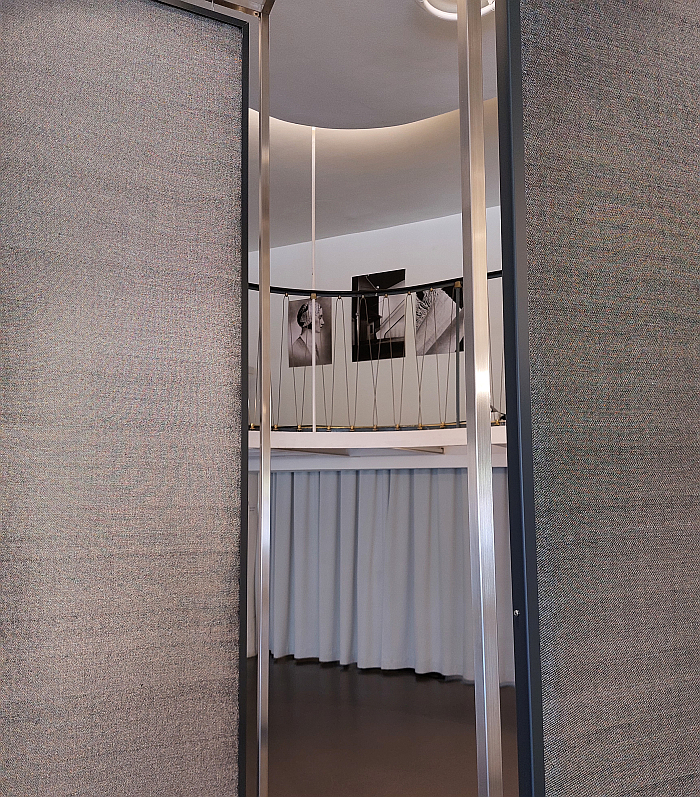
A 3D approach to Berger's textiles, and to Berger, by Raum and Stelz particularly neatly illustrated by the example of a daybed cover Berger designed in 1937 for Walter and Ise Gropius when all three were resident in London, a daybed commissioned from the similarly London based Marcel Breuer, and reconstructed by Raum and Stelz as a skeleton frame which allows one to appreciate how Berger designed the cover to be physically functional on the daybed, to define the daybed within itself and also to set the daybed as a component of the space, its contribution to the architecture of the space. Or at least that's what one sees in photos: the climatic limitations of the Bauhaus-Archiv's temporary home negating the possibility of displaying any actual archival textiles, something that while regrettable, doesn't detract from the presentation. Not least because through the various aspects of the presentation one has sufficient information to appreciate the daybed cover in context of an Otti Berger's wider positions and approaches, including in her statements that "we can speak of a fabric’s sculptural aspect. The fabric becomes expression. What do we then still need flowers, vines, ornaments for? The fabric itself is alive", and that "we do not want pictures, we want to achieve the best possible, definitive, living fabric!", statements that on the one hand help underscore that for all the Modernist Functionalist spaces of the 1920s and 30s are often considered as austere and cold and empty, that is often only on account of all that which we've forgotten, all that which in the intervening century has got lost, not least through an ongoing reduction of 'Bauhaus' to an increasingly simplified and generalised and blithely accepted definitive definition, or to an opportunity to sell steel tube furniture that has but only little to do with the institutions..... things we've forgotten including the roles and functions of textiles in and of inter-War architecture, roles and functions developed in context of and in conjunction with the new positions on and to architecture, and whose overlooking today means that we can't see the spaces of then, just our contemporary interpretation of the spaces, an interpretation arrived at from incorrect perspectives and which thereby contains errors, which, yes, is also a metaphor.
And on the other hand are statements, positions, that tend to separate an Otti Berger, a Bauhaus Dessau alumni from an Else Mögelin, a Bauhaus Weimar alumni, who, as we all learned from Else Mögelin. Ich wollte, gegen alle Hindernisse, weben at the Brandenburgisches Landesmuseum für moderne Kunst, Cottbus, very much did want 'pictures', actively developed pictures, very engaging pictures, and who was a proponent of hand-weaving in contrast to Otti Berger who was very much industrially focussed, not just creating textiles for industrial manufacturers to produce but textiles for the industrial society, while Mögelin, one can, could, argue, not least through much of her imagery, was more about craft production for agrarian society. Thus reminding us that the positions on "what fabric is, and further, what fabric in space is" held by Otti Berger weren't universal, neiter were the positions on architecture and design, any period is always a mix of positions from which a way forward emerges. Including our own. In addition Berger's murder at the hands of the NSDAP offers differentiated perspectives on Mögelin's attempts to quietly fit in, to ignore the horrors of the age, and the question of how should, must, one respond to totalitarian regimes when you aren't directly threatened. That very contemporary question of responsibility for others, often others unknown, in context of responsibility to yourself.
And on the rare and thus particularly valuable third hand statements, positions, that allow the functional textiles of an Otti Berger to be approached in context of the functional fabrics of the Middle Ages, fabrics that much as Bergers's were, without question, produced in context of the architecture of the day, were produced as a component of the architecture of day, were, if one so will Weaving for Middle Ages Architecture, certainly in terms of the houses of the lords and church, those of the peasants must always be considered separately..... however functional components of the architecture that also had an important representative function through their imagery, through their pictures, were ostentatious ornamentation, a representative function of fabrics Otti Berger rejected, much as elsewhere representative architecture or furniture was rejected. Rather, we'd argue and arguement can be made, for an Otti Berger fabrics were to be functional in and off themselves, something that contributed to the space every bit as much as the shape of the space, the placing of the windows, the height of the ceilings, etc, etc, because that was their function and was accepted as such, but which also brought life and emotion and non-physical warmth to a space, rather than the show of yore or as she phrases it, "through material, we want to achieve the dissolution of material! — a piano cover, for example, can be music in itself, flowing, harmonious, full of melody and vibrations".
Can be if approached with an Otti Berger's appreciation of "what fabric is, and further, what fabric in space is".
Can be if one approaches fabrics as active components of space as active components of architecture.
And can be once again, once one frees it from its archive enforced flatness.
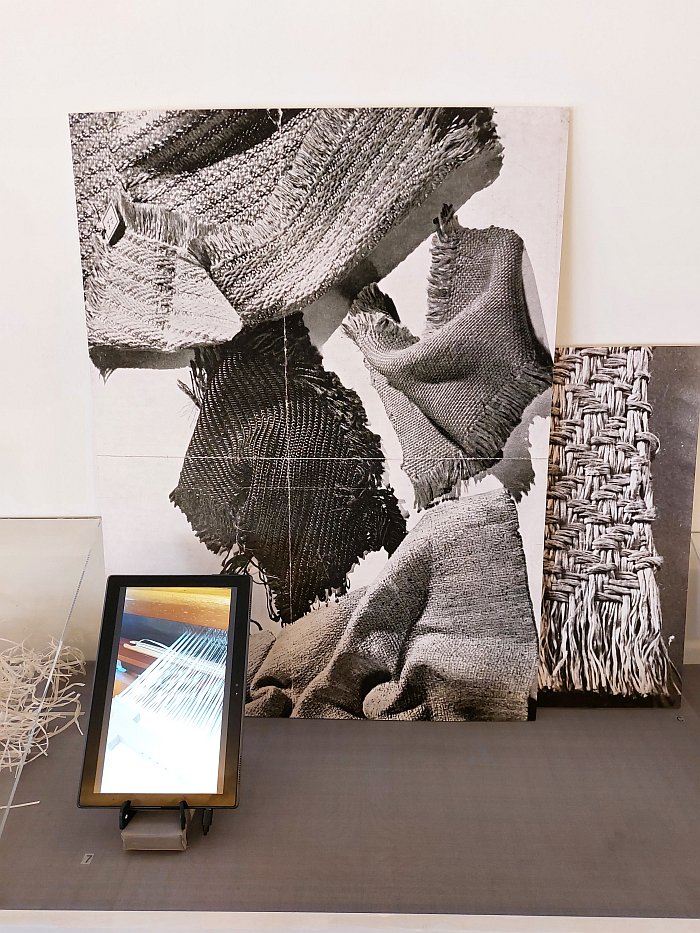
A, by necessity of the aforementioned spatial limitations of the Temporary Bauhaus-Archiv, spatial and climatic limitations which underscore the very real need to get the permanent Bauhaus-Archiv rebuilt and reopened ASAP, and also to allow access to the archive again, we've all been without it for far too long..... a, by necessity bijou presentation, Weaving for Modernist Architecture provides nonetheless for a very stimulating and satisfying introduction to Otti Berger, her work, approaches, positions and for all to her textiles. And her understandings of "what fabric is, and further, what fabric in space is".
An introduction continued in the the publication Otti Berger. Weaving for Modernist Architecture, a publication that is, arguably, the, as yet, most expansive component and embodiment and expression of Judith Raum's research.
A publication which aside from discussing in more detail the various categories of material Otti Berger developed and worked with, and in doing so helping reinforce that Otti Berger designed for and with industry if with a craft background, also takes a closer look at, for example, Atelier für Textilien Otti Berger, Berger's complicated relationship with Ludwig Hilberseimer, her text-tiles, or the folk influences in her work, for lest we forget, as again we all to regularly do, for all the striving forwards of the period and its practitioners, the folkloric had an important role in the development of Modernist positions, particularly in those arising along expressionist paths and those arising from the east of Europe. Those arising from Germany occasionally also having a folkloric element, if more in the sense of Germanic, heroic, aryan, supremacist, folklore, a subject to which we shall return soon.
A publication which goes far beyond Otti Berger herself to discuss, for example, the wider contexts in which her work was realised, or not, the wider creative circles in which she not only moved but in which she can be approached and understood or the wider relevance of Otti Berger to debates on the (hi)story of architecture and design including her slide into anonymity, an act inarguably aggravated by the fact she was denied the chance to write a post-War biography, a fate she shares with a great many, not least the Lilly Reich with whom she otherwise shares so very little. And the associated information that can be gleaned through Otti Berger about how difficult it is to retrace a creative's biography after the fact, for all when you are reliant on textiles a source that as one learns from Weaving for Modernist Architecture, can be a troublesome, misleading, deceptive source, if also highly informative once accurately understood.
And for all a publication that serves as an excellent platform for further research into not only Otti Berger but a period in European architecture and design from which we have forgotten so much and which is very much in need of freeing from the simplified, definitive narrative via which it is popularly understood.
Or perhaps better put, a period in European architecture and design very much in need of freeing from the flatness in which is currently curated.
Otti Berger is apposite place to begin that popular freeing.
And simultaneously to allow Otti Berger to regain a popular visibility that, much as with the lack of recognition for the relevance and informativeness of her work, she currently doesn't enjoy but which Weaving for Modernist Architecture, showcase and book, very much confirms she should.
Otti Berger. Weaving for Modernist Architecture is scheduled to run at the Temporary Bauhaus-Archiv / Museum für Gestaltung, Knesebeckstrasse 1, 10623 Berlin, until Saturday August 24th
Full details can be found at www.bauhaus.de
Otti Berger. Weaving for Modernist Architecture, Judith Raum, Bauhaus-Archiv Berlin / Museum für Gestaltung [Eds.], is published by Hatje Cantz Verlag, Berlin in English and in English with a German supplement. More details can be found at www.hatjecantz.com
![Judith Raum, Bauhaus-Archiv Berlin / Museum für Gestaltung [Eds.] Otti Berger. Weaving for Modernist Architecture, Hatje Cantz Verlag, Berlin](https://www.smow.com/blog/wp-content/uploads/2024/03/Otti-Berger-Weaving-for-Modernist-Architecture-Temporary-Bauhaus-Archiv-Berlin-hatjecantz.jpg?w=3840)
1and all other quotes unless stated, taken from Judith Raum, Bauhaus-Archiv Berlin / Museum für Gestaltung [Eds.], Otti Berger. Weaving for Modernist Architecture, we have however, in contrast to the book started all sentences with capital letters, sorry but while we understand the arguments for all small, without a capital at that start of a sentence any text is utterly unreadable, the other words are less important. The original text was published, in German, in Revue Devětsilu, ReD, vol. 3, no. 5, 1930, pages 143–45, thus in the ReD Bauhaus special. ReD being the magazine that was, as we all learned from Hej rup! The Czech Avant-Garde at the Bröhan Museum, Berlin, the official publication of the collective Devětsil one of the prime movers in that avant-garde and thus helping further underscore the degree to which the varying positions and movements of the 1920s and 30s were linked across Europe. And of the importance of looking east and west when trying to understand those connections.......
2see, Judith Raum, Bauhaus-Archiv Berlin / Museum für Gestaltung [Eds.], Otti Berger. Weaving for Modernist Architecture, page 311 In addition her hearing problems meant that Berger had problems, for example, when telephoning and which makes her establishment of her own studio all the more noteworthy and informative.
3see, Evelyn Schweynoch, Die Firma C. E. Baumgärtel & Sohn GmbH in Lengenfeld im Vogtland in Olaf Thormann [Ed.], Bauhaus Sachsen, Arnoldsche Art Publishers, Stuttgart, 2019 page 418
4According to a letter by Otto Berger, who survived Auschwitz as the only of the four Bergers deported there, to her long-time partner Ludwig Hilberseimer, quoted in Judith Raum, Bauhaus-Archiv Berlin / Museum für Gestaltung [Eds.], Otti Berger. Weaving for Modernist Architecture (page 325), Otti Berger was murdered on account of her (partial) deafness. And while Otti Berger was primarily murdered on account of her Jewish ancestry, the addition of her deafness does allow Otti Berger to stand as a particularly potent symbol, and unequivocal reminder, of the inhuman brutality of the NSDAP.
[caption id="attachment_113658" align="aligncenter" width="627"] Judith Raum, Bauhaus-Archiv Berlin / Museum für Gestaltung [Eds.] Otti Berger. Weaving for Modernist Architecture, Hatje Cantz Verlag, Berlin[/caption]